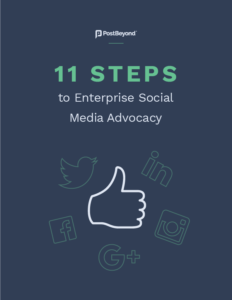We’ve all been there: ready to hit “publish” on a piece of content that we think is great. It’s a well-written, beautifully designed piece that your network is going to love.
DONE.
It’s out there. And now we wait for the response. And we wait. Annnnnd we wait. Then we check in tomorrow, and much to our dismay – nothing. No shares. No downloads. No comments.
All of this great content with no response. What gives?

Yep, it’s a bad feeling. Teachable moments like these remind us that content isn’t as simple as publishing and hoping for the best. So where did it go wrong?
Content is your marketing currency. It cannot succeed without a thorough and well-defined strategy behind it. But how do you create a content strategy for your enterprise?
Creating a Content Strategy
Like most areas of social business, content strategy relies heavily on goal-setting and KPI’s. Ask yourself how your business will define “successful” content. Is it through number of shares from your employees? Number of reshares from your employees’ followers? Number of email signups or contact form completions?
There are no wrong answers, but it’s important to define these KPI’s from the get-go.
Next you’ll want to consider what type of content you’ll be sharing. When thinking about the content strategy for your Employee Advocacy program, consider the following questions:
- Do you have existing content you can use?
- Will you have to create new content specific for your employees’ interests?
- What’s your content marketing budget?
- How many people are on your content marketing team?
- How much time is required to create new content?
- Do you have experts internally that can help with content creation?
- Will you be curating industry content?
- What are your customers interested in?
- What are recruits interested in?
- What kind of content will make your company stand out?
- What kind of content will help build the thought leadership of your employees?
Answering these questions will ensure that your content is made with a purpose and won’t get lost along the way.
Content Strategy in Practice
We’re constantly refining our content strategy here at PostBeyond. Everything we put out there, be it a blog post, a tweet, or a guide, is measured and tweaked as necessary. We’re constantly asking ourselves what performs, what doesn’t, and how we can improve. It’s a very calculated process – and we’re happy to share it with you!
Each piece of content we share is created with one of the following goals in mind:
- Thought Leadership
- Relationship Nurturing
- Lead Generation
- PostBeyond Culture
- Customer Success
Once the goals of the content are defined, we then decide which content type would best achieve those goals.
- Email Blasts
- Blog Posts
- Guides
- Video/Webinar
- Internal
As we’re creating this content, we keep our initial KPI’s in mind. How will this piece of content both provide value for the reader and help us reach our goals? What will inspire our readers to return to our site? What will compel them to request a demo? And how can this specific piece of content achieve that?
We craft these pieces with our goals in mind, publish, and everyone on our team shares it to their own personal networks (and PostBeyond’s social channels, too!)
After that it’s a matter of testing, re-testing, measuring, and more testing. Through various programs like Google Analytics or Pardot, we measure which pieces are performing well, and which ones may need some changing.
Let’s say we have a downloadable guide that continues to outperform other content pieces in our library. It’s our job to determine…
1. What is making this content piece successful in relation to our KPI’s.
- Was it shared more frequently than our other content pieces?
- Did the high number of downloads generate any further leads (like demo requests?)
- Was it shared on different channels than we typically share on?
- Did we experiment with a different style of wording or imagery?
- Was there an influencer who decided to share this piece with their network?
- Was there any feedback on our channels that states why our readers found this content valuable?
2. How we can continue to leverage this content for leads:
- What part of this content was valuable for our readers? Can this lead to a separate piece of content on its own?
- Is this a piece of content that we can update with new research findings in the future?
- Are there any influencers who have provided thought leadership on this subject that may be interested in sharing our content?
Employee Advocacy Content Strategy That We Use Internally
One of the most important aspects of our content strategy is our own platform. We share all of our new content pieces via the platform itself to increase our own employee advocacy. Woah – that was meta. Let me explain:
Our content is about employee advocacy and the idea of becoming a social business. In order to prove the efficacy of these concepts, we need to live it. Therefore, all PostBeyond content is published and suggested for sharing through PostBeyond itself.
Our team is then free to share the content on their networks, and are encouraged to share it directly with some influencers or thought leaders that would be interested. Our employee advocates are an integral part of our content strategy.
We typically suggest and share these different content categories in our platform:
- Company culture: Pictures of our employees working in the office, events outside the office, employee features, etc. which results in better employer brand.
- Industry influencers and media: We target specific influencers that write about our industry and curate their content to be shared by our team in order to further build key relationships.
- PostBeyond articles: Any original blog post we publish gets pushed through our platform to help generate traffic to our website.
- PostBeyond assets: Any downloadable content we publish gets shared by our employees, ultimately resulting in more downloads and leads.
- PostBeyond jobs and career opportunities: We add any new job postings to our platform, which leads to generating social recruits from our employees.
- Industry Research: Any research or data that’s relevant to our industry gets added to our platform, so that employees can share and build their thought leadership in the industry.
- PostBeyond media coverage: We add any media mentions and coverage we have to our platform, so our employees can help build brand awareness and 3rd party validation of our company.
With this mixture of curated content and our own content strategy being shared through our platform, we’re able to hit our lead generation and brand awareness goals, through digital and social.
Your Strategy
 It’s likely that your organization will have different goals depending on your employee advocacy program. If, for example, your over-arching goal with the program is to increase social recruitment efforts, your content strategy would largely focus on company culture.
It’s likely that your organization will have different goals depending on your employee advocacy program. If, for example, your over-arching goal with the program is to increase social recruitment efforts, your content strategy would largely focus on company culture.
Remember: content should be an ever-evolving part of your marketing program. It will require meticulous measurement to make sure that it stays engaging.
By answering the above questions, you’re already on your way to creating an amazing content strategy that encourage your employees to share!
If you want to know more about how to successfully implement an employee advocacy program, download our guide to becoming a social business.
What’s in your content strategy? What are your goals? Do your employees help share your content? Please leave a comment below, and share with your colleagues!




